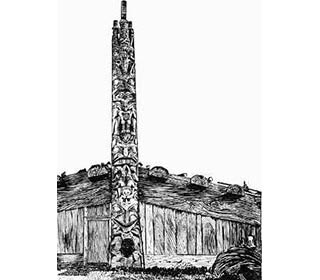Totem poles are carved and painted with symbols and totems or figures such as animals, that represent the emblems of clans or families and relates to their belief in Totemism. A totem is an emblem, such as an animal or plant, that is believed to have spiritual significance and watches over the family, clan, or tribe symbolizing their guardian spirit or helper refer to Totem Pole Art and Design. The word totem is derived from the Ojibwe (Chippewa) word 'odoodem' meaning "his kinship group". Totem Poles were not worshipped but they inspired respect. Who made the Totem Poles?
Totem Poles were not created by all Native Indian tribes and their production was limited to six Northwest Indian tribes located in the Pacific Northwest Coast in British Columbia and southeastern Alaska. The names of the Northwest Tribes which carved Totem Poles were as follows: - The Tlingit tribe
- The Haida tribe
- The Bella Coola tribe
- The Kwakiutl tribe
- The Tsimshian tribe
- The West Coast tribe
In the culture of the Northwest people Totem Poles were erected in the front of a Northwest Native Indian's home and would show the ancestry and the social rank of the family. The figures carved on the Totem poles could be humans, animals, or other creatures. Purpose and Reason for Totem Poles
Totem poles were made to fill a variety of needs, but their primary purposes were to commemorate people or special events. The first totem poles were carved as part of an elaborate Potlatch ceremony which was a great, expensive feast with deep meaning. Totem poles were later created for other reasons. The Principal purposes and reasons for Totem Poles were: - Potlatch Pole - to symbolize the generosity of the person who sponsored the Potlatch ceremony
- Legend Pole - To record a supernatural encounter
- Memorial Pole - To commemorate the life of an important person
- Burial Pole - totem poles were used as grave markers, grave posts or mortuary totem poles
- Heraldic Pole - Recording the history of clans or families
- Portal or Entryway pole - through which a person enters the house, identifying the owner and family of the house
- Ridicule pole, also called shame pole - symbolic reminders of debts, quarrels, murders, and other objectionable occurrences
- Indoor House Pole - supported the roof and bore emblems of the clan
- Welcoming Pole - situated on waterfronts and identifying ownership of the water and surrounding area
Totem Poles - A Sign of Affluence
Totem poles a sign of affluence, a display of wealth. They were expensive and time consuming to construct requiring significant manpower in their construction and erection, which is why they are generally found near the houses of Native American chiefs. A totem pole in front of a Native Indian's home would show the ancestry and the social rank of the family. They validated the powerful rights and privileges that the family held. Locations of Totem Poles
The locations of totem poles vary. Some stand in front of the houses, or very near them; others posts are set near the waterfront or beach, beyond the village. For additional, interesting info refer to How to make a Totem Pole. Symbols on Totem Poles
Totem Poles are created using Pictography, or writing with pictures and symbols. Totem poles have unique features and colors depending upon the clan or tribe. Their interpretation requires knowledge of the customs, traditions and history of the clan or family. Every color used on the Poles have meanings as do the figures carved on the Totem Poles. The Symbols for every animal or spirit carved on the pole also have meaning and when combined on the pole, in sequence, constitute a story, legend or myth. Meaning of Totem Poles - Carvings and Symbols
The meaning of Totem Poles can be interpreted from the carvings and symbols that tell a story. - Every animal depicted on a Pole had a special meaning, characteristics and significance - refer to Animal Totems
- Every color had a special meaning and significance
- Every tribe and clan or family had a special animal totem and their poles were associated with specific colors
- The position of figures on the pole were significant
- Directional colors - Some colors symbolized the four cardinal points
The Decay of Totem Poles
As totem poles become old they decay and become weather-beaten and gray in color. Groups of old poles are sometimes compared to a forest of tree trunks left after a fire has swept through a wooded district. Creating Totem Poles - How long did it take?
The length of time taken to carve and paint the poles clearly depended on the size of the pole and the intricacy of the carving. Generally totem poles could take between 3 and 9 months to complete and required the skills of the experienced carver and his helpers. | 